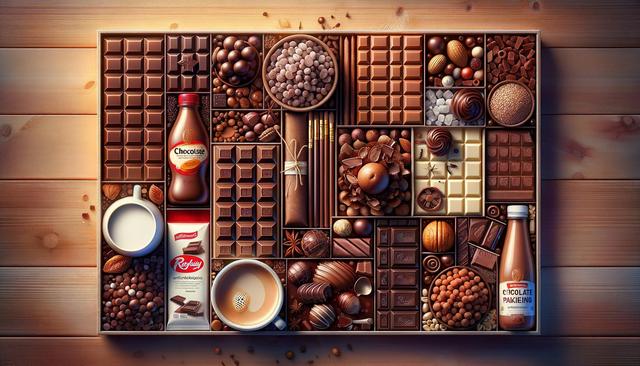The Importance of Chocolate Packaging Chocolate packaging serves a critical role in the confectionery industry, far beyond mere aesthetics.
It is a complex blend of art and science that not only protects the product but also enhances its appeal and communicates its unique story.

Protection and Preservation of Chocolate
Chocolate is a delicate product that can be affected by various external factors such as heat, moisture, and light. Effective packaging for chocolates ensures that these elements are kept at bay, preserving the texture, flavor, and quality of the product. The choice of chocolate packaging material plays a vital role in maintaining product integrity during storage and transportation. Materials such as foil, laminated paper, and specially designed plastics help create a barrier against environmental hazards.
Some of the key protective functions of chocolate packaging include:
- Preventing oxidation that could alter taste and appearance
- Shielding against humidity which may cause blooming
- Ensuring hygienic handling and reducing contamination risk
In addition to basic protection, advancements in chocolate foil packaging machine technology have allowed for more efficient and airtight sealing processes, further extending shelf life and ensuring consistent quality across batches.
Visual Appeal and Consumer Engagement
Packaging is often the first thing a consumer notices, making it a crucial aspect of brand identity and marketing. Visually appealing packaging for chocolates can significantly influence purchasing decisions, especially in a competitive retail environment. Colors, typography, and illustrations all work together to create an emotional response that resonates with the target audience.
Personalized chocolate packaging is becoming increasingly popular, allowing brands to tailor their designs for seasonal campaigns, special occasions, or corporate gifts. These customized packages not only stand out on shelves but also create memorable unboxing experiences. Eye-catching packaging helps products stand out, especially when paired with high-quality materials and thoughtful design elements.
Modern consumers are drawn to packaging that tells a story or reflects their values, such as sustainability or artisanal craftsmanship. This emotional engagement often turns occasional buyers into repeat customers.
Material Innovation and Sustainability
The growing demand for environmentally responsible products has led to innovation in chocolate packaging material. Brands are moving away from traditional plastic and packaging products that are non-biodegradable, and instead are exploring compostable films, recycled paper, and bio-based plastics. These materials not only reduce environmental impact but also appeal to eco-conscious consumers.
Some sustainable packaging solutions include:
- Biodegradable cellulose films
- Recycled cardboard boxes
- Compostable inner linings
Choosing the right material also depends on the type of chocolate, whether it’s solid bars, truffles, or filled confections. Each requires a unique level of protection and presentation, which can be achieved through thoughtful material selection and design integration. The use of efficient chocolate foil packaging machines also minimizes waste during production, adding another layer of sustainability.
Technological Advancements in Packaging
Technology has transformed chocolate packaging, making it more efficient, customizable, and secure. A notable development is the chocolate foil packaging machine, which automates the wrapping process with precision and consistency. These machines are capable of handling high volumes while maintaining quality, making them essential for both small and large-scale chocolate producers.
Other technological enhancements include:
- Smart packaging that uses QR codes for traceability
- Modified atmosphere packaging to extend shelf life
- Heat-sealing and tamper-evident features for added security
With automation, manufacturers can offer more variety in personalized chocolate packaging without compromising on speed or efficiency. This flexibility is particularly beneficial for brands that cater to niche markets or seasonal demands, allowing them to adapt quickly to consumer preferences.
The Role of Branding in Chocolate Packaging
Beyond functionality and aesthetics, chocolate packaging is a powerful tool for brand storytelling. It communicates the values, heritage, and personality of a brand, often within a few seconds of consumer interaction. Whether it’s a minimalist design for a premium product or a vibrant look for a playful brand, packaging choices speak volumes about what the company stands for.
Personalized chocolate packaging can be used to create limited edition collections, celebrate local culture, or highlight collaborations, making the product more engaging. Consistency in packaging elements such as logo placement, color schemes, and typography helps reinforce brand recognition and loyalty.
Moreover, packaging allows brands to share details about sourcing, production methods, and certifications, which are increasingly important to today’s informed consumers. By using packaging as a communication channel, companies can connect with buyers on a deeper level and differentiate themselves in a crowded marketplace.
Conclusion: More Than Just a Wrapper
Chocolate packaging plays a multifaceted role that extends well beyond visual appeal. It protects the product, influences consumer behavior, enables sustainability, and serves as a key component of brand identity. For businesses in the confectionery industry, investing in high-quality packaging for chocolates—whether through advanced chocolate foil packaging machines or sustainable chocolate packaging material—is not just a necessity but a strategic advantage.
As consumer expectations evolve, so too must the approaches to packaging. Whether through personalized chocolate packaging or innovations in plastic and packaging products, staying ahead in packaging trends can significantly enhance a brand’s reputation and market presence.